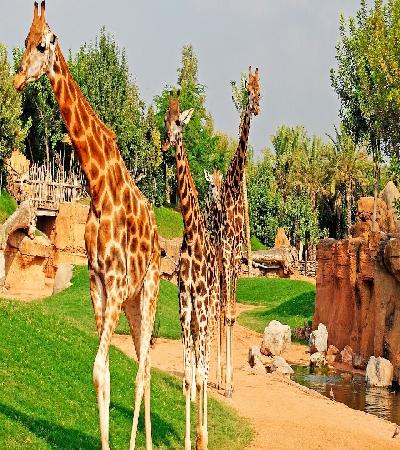 In 2008, the Valencia Biopark was inaugurated. This zoo is not ordinary like its kind. People and animals are not separated by crystals and barriers, but by ponds, plants, and rocks, making visitors feel as if they are immersed in animal habitat. Everything in the biopark is done so that the conditions of the animals come as close as possible to those in which they live in the wild. Animals that usually live in the same area are placed next to each other and some animals, lemurs for example, can freely meet and "communicate" with people without any barriers.
In 2008, the Valencia Biopark was inaugurated. This zoo is not ordinary like its kind. People and animals are not separated by crystals and barriers, but by ponds, plants, and rocks, making visitors feel as if they are immersed in animal habitat. Everything in the biopark is done so that the conditions of the animals come as close as possible to those in which they live in the wild. Animals that usually live in the same area are placed next to each other and some animals, lemurs for example, can freely meet and "communicate" with people without any barriers.
The flora and fauna of the savanna, the jungle, the African continent and the subtropics are represented in the Valencia Biopark.
The zoo area is divided into 3 zones: La Sabana, Equatorial Africa and Madagascar.
In the African savannah area, large herbivorous animals such as giraffes, zebras, and antelopes can be found grazing peacefully among plants. White rhinos live in a separate location, not far from the river. Visitors have the opportunity to see the underground life of Africa, that is, the termites that swarm in their termite house. The mountainous part of the savanna is "covered" with lions. Wild lions often rest on the tops of rocks where the terrain is well visible. The area, dedicated to exotic birds, is nearby, with a good view of the rocky peaks, where the lions rest.
However, it is worth remembering that the biopark has rules that must not be broken: animals should not be touched or fed, or scared by screaming or with flash cameras.
Another attraction that cannot be overlooked is the "baobabs forest", although the biopark baobabs are not entirely real.
In the equatorial Africa area you can see primates (gorillas), antelopes among other species, as well as herds of red buffalo. In this part of the biopark the Kitum cave is recreated, or rather a small part of it, the natural analogue of which is created by extracting salt from its walls from a herd of elephants.
The Madagascar area is "inhabited" by animals that are used to this island. There are only 7 species of lemurs! Incidentally, Madagascar has a large number of endemic species, that is, animals that live only on the island and nowhere else in the world, 80%. Because the island was isolated from Africa 160 million years ago.
There are also several cafes and restaurants within the park, where you will have time for lunch.
Animals, vegetation and landscape form an ecosystem in which visitors can learn about the relationship between organisms and the elements that make up the ecosystem so that they can understand them.
Address: Av. Pío Baroja, 3, 46015 València, Valencia, Spain
Telephone: +34 960 66 05 26
